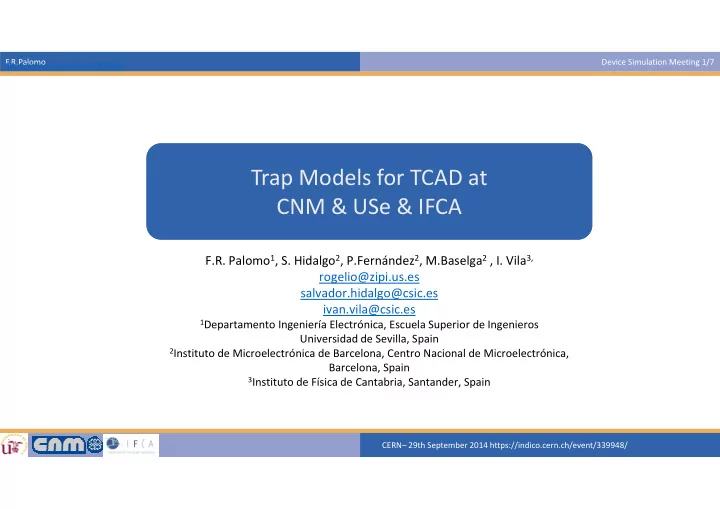

F.R.Palomo Device Simulation Meeting 1/7 https://indico.cern.ch/event/339943/ Trap Models for TCAD at Trap Models for TCAD at CNM & USe & IFCA CNM & USe & IFCA F.R. Palomo 1 , S. Hidalgo 2 , P.Fernández 2 , M.Baselga 2 , I. Vila 3, rogelio@zipi.us.es salvador.hidalgo@csic.es ivan.vila@csic.es 1 Departamento Ingeniería Electrónica, Escuela Superior de Ingenieros Universidad de Sevilla, Spain 2 Instituto de Microelectrónica de Barcelona, Centro Nacional de Microelectrónica, Barcelona, Spain 3 Instituto de Física de Cantabria, Santander, Spain CERN– 29th September 2014 https://indico.cern.ch/event/339948/
F.R.Palomo Device Simulation Meeting 2/7 https://indico.cern.ch/event/339943/ Outline • Trap models in Sentaurus TCAD • Tuning Parameters • Models we use Trap Models • No intention to put the whole trap taxonomy we find in experiments • TCAD would be unable to converge • Effective trap models • No more than 4 trap models [1] • 5 parameters per model (type, energy, σ e , σ h , concentration) • There is no “model that fits for all” • The models have to be checked with experimental data • Effective models fitted for each situation, limited predictive power • Model Box approach, we take the better for data fitting Numerical simulation of radiation damage effects in p-type and n-type FZ silicon detectors, F.Moscatelli et al. NIMB 186(1-4), 2002, pp171-175 CERN– 29th September 2014 https://indico.cern.ch/event/339948/
F.R.Palomo Device Simulation Meeting 3/7 https://indico.cern.ch/event/339943/ Perugia Model (Petasecca et al.) n-type silicon Perugia model Good simulation of leakage currents p-type silicon Perugia model for diodes (n+/p/p+ p-type silicon) Numerical simulation of radiation damage effects in p-type and n-type FZ silicon detectors, M.Petasecca et al. IEEE TNS 53(5), 2006 pp2971-2976 Numerical simulation of radiation damage effects in p-type silicon detectors, NIMA 563 (1), 2006, pp192-195 CERN– 29th September 2014 https://indico.cern.ch/event/339948/
F.R.Palomo Device Simulation Meeting 4/7 https://indico.cern.ch/event/339943/ Pennicard Model (CNM-Glasgow) p-type silicon Pennicard model (adapt from Perugia model) Comparison between simulated and experimental CCE in a “3 column” ATLAS detector. p-type silicon Perugia model Simulated “3 column” 10 16 n eq /cm 2 ATLAS detector Reason: Perugia free trapping not enough, correct leakage current (or effective dopping) so new σ c , σ h are defined. Simulations of radiation-damaged 3D detectors for the Super-LHC, D.Pennicard et al. NIMA 592(1-2), 2008, pp16-25 CERN– 29th September 2014 https://indico.cern.ch/event/339948/
F.R.Palomo Device Simulation Meeting 5/7 https://indico.cern.ch/event/339943/ MOS Capacitors (Pennicard model) p-MOS Capacitor proton irradiation (PS@CERN) For simple MOS capacitors, the donor trap type is the most important. General rule: tune your trap models to reproduce the data Analysis of Displacement damage effects on MOS capacitors, P.Fernández-Martínez, F.R.Palomo et al. NIMA 730, 2013, pp91-94 CERN– 29th September 2014 https://indico.cern.ch/event/339948/
F.R.Palomo Device Simulation Meeting 6/7 https://indico.cern.ch/event/339943/ Our future radiation damage simulations • Working in radiation damage of 3D detectors with our trap models (Pennicard) • But we are open to other models considering CMS interests CERN– 29th September 2014 https://indico.cern.ch/event/339948/
F.R.Palomo Device Simulation Meeting 7/7 https://indico.cern.ch/event/339943/ Thanks for your attention rogelio@zipi.us.es salvador.hidalgo@csic.es ivan.vila@csic.es CERN– 29th September 2014 https://indico.cern.ch/event/339948/
Recommend
More recommend